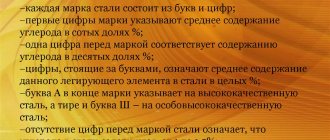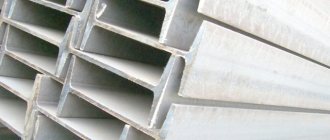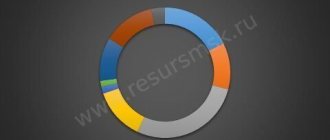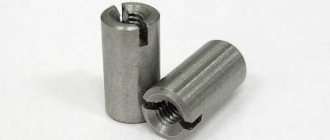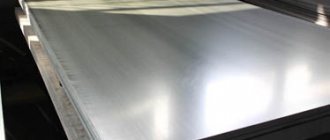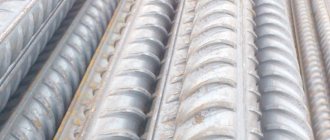Description
St3sp steel is used: for the production of expanded metal sheets, load-bearing elements of welded and non-welded structures and parts operating at positive temperatures; shaped and sheet products (5th category) for load-bearing elements of welded structures operating under variable loads: with a thickness of rolled products up to 25 mm in the temperature range from -40 ° C to +425 ° C, with a thickness of rolled products over 25 mm - from - 20 °C to +425 °C, subject to delivery with guaranteed weldability; blanks for pipeline fittings; forgings with a diameter of up to 300 mm. strength classes KP 175, KP 195; production of welded transitions, flanges, welded tees and other shaped parts of NPP pipelines with operating temperatures from -20 °C to +200 °C; as the main layer in the production of hot-rolled two-layer corrosion-resistant sheets; hot-rolled trough, single-groove and C-shaped profiles for agricultural machines; profile for the tractor final drive housing; hot-rolled profiles for the manufacture of wheel rims for agricultural machines; electric welded pipes for the manufacture of parts and structures in the motorcycle and bicycle industry; double-headed, T-bar and P5 type rails intended for ground and overhead tracks; steel bent closed welded square and rectangular sections intended for use in agricultural engineering, tractor manufacturing and other sectors of the national economy; hot-rolled steel profiles for sheet piles intended for cellular structures and impervious curtains; spikes of accuracy class C, intended for fastening railway rails to wooden sleepers and beams; solid-rolled rings for various purposes.
Note
Degree of deoxidation - Sp. Long products, strip and shaped products are manufactured with a strength class of 265 with a cross-section of up to 20 mm. During hardening treatment (regulated or controlled rolling or accelerated cooling), rolled products with a cross section of up to 20 mm are supplied in strength classes 295, 325 and 345. St3sp steel provides the strength class of sheet, wide universal rolled products and bent profiles KP 265 with a rolled thickness of up to 20 mm without the use of additional hardening treatment.
St3sp5 decoding what 5 means
Steel.
Types and grades of steel. Their application. Steel is an alloy of iron and carbon with other elements, the carbon content in it is no more than 2.14%.
The most general characteristic is that steel is classified according to its chemical composition:
carbon steel (Fe – iron, C – carbon, Mn – manganese, Si – silicon, S – sulfur, P – phosphorus). Based on carbon content, it is divided into low-carbon, medium-carbon and high-carbon. Carbon steel is designed for statically loaded tools.
alloy steel - alloying elements are added: nitrogen, boron, aluminum, carbon, phosphorus, cobalt, silicon, vanadium, copper, molybdenum, manganese, titanium, zirconium, chromium, tungsten, nickel, niobium.
According to the production method and impurity content, steel differs:
ordinary quality steel (carbon less than 0.6%) – corresponds to GOST 14637, GOST 380-94. St0, St1, St2, St3, St4, St5, St6. The letters “St” indicate ordinary quality steel, the numbers indicate the marking number depending on the mechanical properties. It is the cheapest steel, but inferior in other qualities.
high-quality steel (carbon or alloy) - GOST 1577, carbon content is indicated in hundredths of % - 08, 10, 25, 40, the degree of deoxidation and the nature of solidification can additionally be indicated. High-quality carbon steel has high ductility and increased weldability.
Low-carbon high-quality structural steels are characterized by low strength and high ductility. Parts for cold stamping are made from sheet steel 08, 10, 08kp. Bolts, screws, nuts, axles, hooks, studs and other parts for non-essential purposes are made from steels 15 and 20.
Medium-carbon quality steels (st. 30, 35, 40, 45, 50, 55) are used after normalization and surface hardening for the manufacture of parts that have high strength and core toughness (axles, screws, bushings, etc.)
Steel 60 - steel 85 have high strength, wear resistance, and elastic properties. Crane wheels, rolling rolls, compressor valves, springs, leaf springs, etc. are made from them.
high quality - complex chemical composition with low phosphorus and sulfur content - according to GOST 19281.
Steel is also divided by application:
a) construction steel - carbon steel of ordinary quality. Has excellent weldability. The number indicates the conditional number of the steel composition according to GOST. The higher the reference number, the higher the carbon content, the higher the strength of the steel and the lower the ductility.
St0-3 - for secondary structural elements and non-critical parts (flooring, railings, lining, washers)
St3 is used for load-bearing and non-load-bearing elements of welded and non-welded structures and parts that operate at positive temperatures. GOST 380-88.
The quality standard provides for steel with an increased amount of manganese (St3Gsp/ps, St5Gsp/ps).
b) structural steel - GOST 1050
Carbon-based high-quality structural steels are used in mechanical engineering, for welded, bolted structures, for roofing work, for the manufacture of rails, railway wheels, shafts, gears and other parts of forklifts. The numbers in the marking indicate the carbon content in tenths of a percent.
St20 - lightly loaded parts, such as rollers, copiers, stops,
St35 - experiencing small stresses (axles, rods, levers, disks, traverses, shafts),
St45 (st40Х) - requiring increased strength (shafts, couplings, axles, racks)
Structural alloy steels are used for tractor tracks, the manufacture of springs, leaf springs, axles, shafts, automobile parts, turbine parts, etc.
c) tool steel - used for cutting tools, high-speed steel for cold and hot deformation of materials, for measuring instruments, for the production of hammers, chisels, chisels, cutters, drills, files, razors, rasps.
U7, U8A (the figure is tenths of a percent in terms of carbon content). Carbon steels are produced in high quality and high quality. The letter "A" stands for high quality carbon tool steel.
d) alloy steel - universal steel containing a special impurity. Silicon content more than 0.5%, manganese more than 1%. GOST 19281-89. If the content of the alloying element exceeds 1 - 1.5%, then it is indicated by a number after the corresponding letter.
low-alloy steel - where alloying elements are up to 2.5% (09G2S, 10HSND, 18KhGT). Low-alloy steel can be used in conditions of the far north, from -70 degrees C. Low-alloy steel is distinguished by greater strength due to a higher yield strength, which is important for critical structures.
highly alloyed (from 10 to 50%)
Steel 09G2S is used for steam boilers, apparatus and containers operating under pressure and temperatures from minus 70 to plus 450 degrees; it is used for critical sheet welded structures in chemical and petroleum engineering, and shipbuilding.
Steel 10HSND is used for welded structures in chemical engineering, shaped profiles in construction, and carriage building.
18ХГТ is used for parts operating at high speeds under high pressure and shock loads.
e) special purpose steel - steel with special physical properties. It is used in the electrical industry and precision shipbuilding.
The weldability of steel is affected by the degree of its deoxidation. According to the degree of deoxidation, steel is classified:
mild steel (st3sp) - completely deoxidized with a minimum content of slag and non-metallic impurities,
chemical composition, application. Steel density s245
Deliver alloy p9 (GOST 19265 - 73, the latest version does not contain the material) in St. Petersburg
The brand name c245 hides low-carbon steel used for building structures and used in welding work without any restrictions. The alloy marking can be presented in the following form - St3ps5 or St3sp5. In fact, we are dealing with steel that is semi-quiet or calm in terms of the degree of oxidation, the proportion of carbon in which does not exceed 0.3%.
Steel s245: chemical composition and GOST standards for products
According to GOST 27772-88, the chemical composition of the C245 alloy is a set of the following elements:
- Fe – about 98%
- C – no more than 0.22%
- Mn – no more than 0.65%
- Ni – no more than 0.3%
- Cr – no more than 0.3%
- Cu – no more than 0.3%
- Si – 0.05-0.15%
- S – no more than 0.05%
- P – no more than 0.04%
- N – no more than 0.012%
S245 steel is used to produce shaped rolled products (including hot rolled):
- GOST 19903 – sheets
- GOST 82 – wide stripes
- GOST 8509 – equal angles
- GOST 8510 – unequal angles
- GOST 8240 – channel
- GOST 8239 and 26020 – I-beams
- GOST 19425 – I-beams and channels
- GOST 8568 – sheets with lentil and rhombic corrugation
- GOST 7511, 8278, 8281, 8282, etc. – bent profiles
Marking of alloys similar to steel grade C245
Low-carbon steel C245, smelted according to GOST 27772-88, can have different markings (according to standards, specifications and regulations):
- St3ps5 or St3sp5 (GOST 380 and 535)
- E235-B, E235-C, Fe 360-B or Fe 360-C (ISO 630:1995 or appendix A GOST 380-2005)
- 18ps (GOST 23570–79)
- VSt3ps6 (GOST 380-71)
- VSt3ps6-1 (TU 14-1-3023–80)
Mechanical properties of alloy c245
Manufacturers do not standardize density for alloy grade C245, however, as reference information, it is most often indicated that the nominal density of steel C245 is 7.85 g/cm3.
S245: application
C245 steel is widely used in the production of rolled metal, which is subsequently used for the construction of all kinds of welded and non-welded structures. Its strength is sufficient to create heavily loaded elements, and the absence of restrictions in weldability allows you to create structures of complex shapes. Note that this carbon alloy contains silicon, magnesium and manganese. The first two elements prevent the formation of ferrous oxide. Manganese neutralizes the destructive effect of sulfur, which makes the metal brittle.
This is interesting: Steel 20x13 - characteristics, application, analogues, composition
Application of steel St3
When considering different grades of steel, you need to take into account the fact that they are classified according to the degree of deoxidation. This chemical process involves removing oxygen from the composition. Too high an oxygen concentration determines a decrease in physical and mechanical properties.
The classification is carried out as follows:
- Calm is characterized by the fact that the composition includes from 0.16 to 0.3% silicon.
- Semi-calm has an average concentration of the element in question.
- Boiling differs in chemical composition from calm in that it contains at least 0.05% silicon.
St3 material is marked accordingly. Various substances can be used to carry out a chemical process.
It is worth considering that a quiet one is much more expensive than other options. This can be associated with the following points:
- The structure is homogeneous, thereby increasing the degree of protection of the material from environmental influences.
- The composition includes a small amount of oxygen, which determines high performance.
Standards
| Name | Code | Standards |
| Ribbons | B34 | GOST 19851-74 |
| Steel pipes and connecting parts for them | B62 | GOST 3262-75, GOST 8696-74, GOST 10704-91, GOST 10705-80, GOST 10706-76, GOST 10707-80, GOST 12132-66, GOST 20295-85, GOST 24950-81, TU 14-3- 1160-83, TU 14-3-1428-86, TU 1380-001-08620133-05, TU 14-3Р-56-2001, TU 14-3-377-99, TU 1373-013-02949352-2003 |
| Ribbons | B24 | GOST 3560-73, GOST 6009-74, STP M309-74 |
| Classification, nomenclature and general norms | IN 20 | GOST 380-2005 |
| Long and shaped rolled products | B22 | GOST 4781-85, GOST 5267.0-90, GOST 5422-73, GOST 5781-82, GOST 8239-89, GOST 8240-97, GOST 8278-83, GOST 8281-80, GOST 8282-83, GOST 8283-93, GOST 8509-93, GOST 8510-86, GOST 9234-74, GOST 10551-75, GOST 10884-94, GOST 11474-76, GOST 12492.1-90, GOST 12492.2-90, GOST 12492.4-90, GOST 12492.5-90 , GOST 12492.14-90, GOST 19240-73, GOST 19425-74, GOST 19771-93, GOST 19772-93, GOST 25577-83, GOST 26020-83, GOST 30565-98, GOST 535-2005, GOST 30136-95, GOST 2590-2006, GOST 2591-2006, GOST 2879-2006, OST 5.9086-85, OST 5.9087-84, TU 14-1-3094-80, TU 14-2-341-78, TU 14-2-853- 89, TU 14-2-949-91, TU 14-1-5282-94, STO ASChM 20-93, TU 14-1-5283-94, TU 14-105-568-93, TU 14-1-5254 -94 |
| Rails. Overlays. Linings. Crutches | B42 | GOST 5812-82, GOST 8142-89, GOST 16277-93 |
| Sheets and strips | B23 | GOST 82-70, GOST 8568-77, GOST 14637-89, GOST 14918-80, GOST 16523-97, GOST 19903-74, GOST 16523-89, GOST 16523-70, GOST 103-2006, GOST 19903-90, TU 36.26.11-5-89, TU 14-1-3023-80 |
| Metal forming. Forgings | B03 | GOST 8479-70, ST TsKBA 010-2004 |
| Welding and cutting of metals. Soldering, riveting | B05 | OST 26-260.453-92 |
| Blanks. Blanks. Slabs | B31 | OST 3-1686-90, TU 14-1-4944-90 |
| Thermal and thermochemical processing of metals | B04 | ST TsKBA 026-2005 |
| Sheets and strips | B33 | TU 14-1-3579-83, TU 14-1-4431-88 |
| Long and shaped rolled products | B32 | TU 14-105-454-86, TU 14-2-849-89, TU 14-11-245-88, TU 14-1-1271-75, TU 14-136-367-2008 |
| Test methods. Package. Marking | B29 | TU 14-106-485-99 |
| Low carbon steel wire | B71 | TU 14-4-1813-97 |
Hand over the alloy x12m (GOST 5950 - 73, the latest version does not contain the material) in St. Petersburg
Description
Hand over alloy 18хгт (GOST 4543 - 71) in St. Petersburg
St3kp steel is used: for the production of expanded metal sheets, light-loaded elements of welded and non-welded structures and parts operating at temperatures from -40 °C to +400 °C; shaped profiles used in carriage building; forgings with a diameter of up to 300 mm. strength classes KP 175, KP 195; hot-rolled trough and C-shaped profiles for agricultural machines; corrugated diamond and point steel for shipbuilding; profile for the tractor final drive housing; electric welded pipes for the manufacture of parts and structures in the motorcycle and bicycle industry; hot-rolled steel sheets with one-sided rhombic and lenticular corrugation; double-headed, T-bar and P5 type rails intended for ground and overhead tracks; steel bent closed welded square and rectangular sections intended for use in agricultural engineering, tractor manufacturing and other sectors of the national economy; spikes of accuracy class C, designed for fastening railway rails to wooden sleepers and beams.
Mechanical properties of steel VSt3sp
Mechanical properties at elevated temperatures
| test t,°C | σ0.2, MPa | σB, MPa | δ5, % | ψ, % | KCU, J/m2 |
| Hot rolled billet dimensions 140x120 mm | |||||
| 20 | 220 | 445 | 33 | 59 | 154 |
| 300 | 205 | 199 | |||
| 500 | 180 | 285 | 34 | 80 | 119 |
| Hot-rolled sheets and shapes up to 30 mm thick | |||||
| 20 | 205-340 | 420-520 | 28-37 | 56-68 | |
| 200 | 215-285 | ||||
| 300 | 205-265 | ||||
| 400 | 155-255 | 275-490 | 34-43 | 60-73 | |
| 500 | 125-175 | 215-390 | 36-43 | 60-73 | |
| A sample with a diameter of 6 mm and a length of 30 mm is forged and normalized. Strain rate 16 mm/min, strain rate 0.009 1/s | |||||
| 700 | 73 | 100 | 57 | 96 | |
| 800 | 51 | 63 | 95 | 95 | |
| 900 | 38 | 65 | 84 | 100 | |
| 1000 | 25 | 43 | 79 | 100 | |
| 1100 | 19 | 31 | 80 | 100 | |
| 1200 | 14 | 25 | 84 | 100 |
Mechanical properties of rolled products
| Heat treatment, delivery condition | Section, mm | σ0.2, MPa | σB, MPa | δ5, % | δ4, % |
| Hot rolled products | 245 | 370-480 | 26 | ||
| Hot rolled products | 20-40 | 235 | 370-480 | 25 | |
| Hot rolled products | 40-100 | 225 | 370-480 | 23 | |
| Hot rolled products | >100 | 205 | 370-480 | 23 | |
| Hot rolled sheets | 370-480 | 20 | |||
| Hot rolled sheets | 2,0-3,9 | 370-480 | 22 | ||
| Cold rolled sheets | 370-480 | 22 | |||
| Cold rolled sheets | 2,0-3,9 | 370-480 | 24 |
Mechanical properties of forgings
| Section, mm | σ0.2, MPa | σB, MPa | δ5, % | ψ, % | KCU, J/m2 | HB |
| Normalization | ||||||
| 175 | 353 | 28 | 55 | 64 | 101-143 | |
| 100-300 | 175 | 353 | 24 | 50 | 59 | 101-143 |
| 195 | 392 | 26 | 55 | 59 | 111-156 | |
| 100-300 | 195 | 392 | 23 | 50 | 54 | 111-156 |
Standards
| Name | Code | Standards |
| Ribbons | B34 | GOST 19851-74 |
| Steel pipes and connecting parts for them | B62 | GOST 3262-75, GOST 8696-74, GOST 10704-91, GOST 10705-80, GOST 10706-76, GOST 10707-80, GOST 12132-66, TU 14-3-1160-83, TU 14-3-1428 -86, TU 14-3Р-56-2001, TU 1373-013-02949352-2003 |
| Ribbons | B24 | GOST 3560-73, GOST 6009-74, STP M309-74 |
| Classification, nomenclature and general norms | IN 20 | GOST 380-2005 |
| Long and shaped rolled products | B22 | GOST 5267.0-90, GOST 5422-73, GOST 5781-82, GOST 7511-73, GOST 8239-89, GOST 8240-97, GOST 8278-83, GOST 8281-80, GOST 8282-83, GOST 8283-93, GOST 8509-93, GOST 8510-86, GOST 9234-74, GOST 10551-75, GOST 11474-76, GOST 12492.1-90, GOST 12492.13-90, GOST 12492.14-90, GOST 19240-73, GOST 19425-74 , GOST 19771-93, GOST 19772-93, GOST 25577-83, GOST 30565-98, GOST 535-2005, GOST 30136-95, GOST 2590-2006, GOST 2591-2006, GOST 2879-2006, OST 5.9086-85, GOST OST 5.9087-84, TU 14-2-341-78, TU 14-2-949-91, TU 14-1-5283-94, TU 14-1-5254-94 |
| Rails. Overlays. Linings. Crutches | B42 | GOST 5812-82, GOST 8142-89, GOST 16277-93 |
| Sheets and strips | B23 | GOST 82-70, GOST 8568-77, GOST 14637-89, GOST 14918-80, GOST 16523-97, GOST 19903-74, GOST 16523-89, GOST 16523-70, GOST 103-2006, GOST 19903-90, OST 5.9094-85, TU 36.26.11-5-89, TU 14-1-3023-80, STP M324-90 |
| Metal forming. Forgings | B03 | GOST 8479-70, OST 5R.9125-84, ST TsKBA 010-2004 |
| Blanks. Blanks. Slabs | B31 | OST 3-1686-90, TU 14-1-4944-90 |
| Welding and cutting of metals. Soldering, riveting | B05 | OST 36-58-81 |
| Sheets and strips | B33 | TU 14-1-3579-83, TU 14-1-4431-88 |
| Long and shaped rolled products | B32 | TU 14-11-245-88, TU 14-1-1271-75, TU 14-136-367-2008 |
Supply of VSt3ps
Supplied in the form of long products, including shaped steel according to the regulations of GOST 380-2005 Carbon steel of ordinary quality (grade), GOST 8281-80 Bent steel channels, unequal flanges, GOST 8278-83 Bent steel channels, equal flanges, GOST 8240-97 Hot-rolled steel channels . 2590-88 Hot-rolled round steel, GOST 8510-86 Hot-rolled unequal-flanged steel angles, GOST 19772-93 unequal-flanged bent steel angles, GOST 19771-93 Equal-flanged bent steel angles, GOST 11474-76 Bent steel profiles (technical conditions), GOST 850 9- 93 Hot-rolled equal-flange steel angles, GOST 9234-74 Bent steel sheet profiles with trapezoidal corrugation, GOST 103-2006 Long-rolled hot-rolled steel strip. Assortment, GOST 82-70 Hot-rolled broadband universal steel, GOST 82-70 Hot-rolled broadband universal steel, GOST 503-81 Cold-rolled low-carbon steel strip, GOST 8734-75 Seamless cold-deformed steel pipes, GOST 10706-76 Electric-welded straight-seam steel pipes ( technical requirements), GOST 10705-80 Electric-welded steel pipes, GOST 20295-85 Welded steel pipes for main pipelines (technical requirements)
The closest equivalents (analogues) of steel 03Х17Н14М3
| USA (ASTM/AISI) | 316, 316, S31600, S31603, S31673, S31683 |
| Germany (DIN, WNr) | 1.4404, 1.4435, 1.4436, X2CrNiMo17-12-2, X2CrNiMo17-12-3, X2CrNiMo18-12, X2CrNiMo14-3, X2CrNiMo17-13-3 |
| Japan (JIS) | SUS316L, SCS16 |
| France (AFNOR) | X2CrNiMo18-14-3, X2CrNiMo18-15-4, Z2CND17-12, Z3CND17-11-02, Z3CND17-12-03, Z3CND18-14-03, Z3CND18-14-08, Z3CND19-15-04, Z6CND18-12- 03 |
| England (BS) | 316L, 316S11, 316S13, 316S14, 316S31, 316S33, LW22, LWCF22, X2CrNiMo18-14-3 |
| Euronorms (EN) | 1.4432, 1.4435, X2CrNiMo17-12-3, X2CrNiMo18-14-3 |
| Italy (UNI) | 316LM1, X2CrNiMo17-13, X2CrNiMo17-13KG, X2CrNiMo18-14-3 |
| Spain (UNE) | F.3533, X2CrNiMo17132 |
| China (GB) | 00Cr17Ni14Mo2, 00Cr17Ni14Mo3 |
| Sweden (SS) | 2343, 2353 |
| Hungary (MSZ) | X2CrNiMo18-14-3, KO38LC |
| Romania (STAS) | 2MoNiCr175 |
| Finland (SFS) | X2CrNiMo17-13-3 |
| Czech Republic (CSN) | 17350 |
| Austria (ONORM) | X2CrNiMo18-14-3KW |
| Australia (AS) | 316L |
| South Korea (KS) | STS316L, STSF316L |
Mechanical characteristics
| Section, mm | sТ|s0.2, MPa | σB, MPa | d5, % | d4 | y, % | kJ/m2, kJ/m2 | Brinell hardness, MPa |
| Electric welded straight-seam pipes (Dy=10-530 mm) as delivered. The mechanical properties of the base metal are indicated | |||||||
| — | ≥225 | ≥372 | ≥22 | — | — | — | — |
| Forgings. Normalization | |||||||
| 100-300 | ≥175 | ≥355 | ≥24 | — | ≥50 | ≥590 | 101-143 |
| 100 | ≥175 | ≥355 | ≥28 | — | ≥55 | ≥640 | 101-143 |
| 100-300 | ≥195 | ≥390 | ≥23 | — | ≥50 | ≥540 | 111-156 |
| 100 | ≥195 | ≥390 | ≥26 | — | ≥55 | ≥590 | 111-156 |
| Hot-rolled thick sheets, sections and shapes in delivery condition | |||||||
| ≤20 | ≥235 | 360-460 | ≥27 | — | — | — | — |
| 20-40 | ≥225 | 360-460 | ≥26 | — | — | — | — |
| 40-100 | ≥215 | 360-460 | ≥24 | — | — | — | — |
| 100 | ≥195 | 360-460 | ≥24 | — | — | — | — |
| Hot-rolled thin sheets in delivery condition. Strength group OK360V | |||||||
| ≤2 | ≥235 | 360-530 | — | ≥20 | — | — | — |
| 2-3.9 | ≥235 | 360-530 | — | ≥22 | — | — | — |
| Cold-rolled thin sheets in delivery condition. Strength group OK360V | |||||||
| ≤2 | ≥235 | 360-530 | — | ≥22 | — | — | — |
| 2-3.9 | ≥235 | 360-530 | — | ≥24 | — | — | — |
| Sheets 12 mm thick as delivered (cross-sectional samples) | |||||||
| — | ≥205 | ≥385 | ≥37 | — | ≥60 | — | — |
| — | ≥190 | ≥370 | ≥27 | — | ≥59 | — | — |
| — | ≥175 | ≥430 | ≥21 | — | ≥51 | — | — |
| — | ≥160 | ≥450 | ≥23 | — | ≥49 | — | — |
| — | ≥150 | ≥395 | ≥35 | — | ≥62 | — | — |
Standards
| Name | Code | Standards |
| Sheets and strips | B33 | GOST 10885-85, TU 108.1273-84, TU 14-1-3579-83, TU 14-1-4912-90, TU 14-1-5032-91, TU 302.02.988-92, TU 14-1-5241 -93, TU 14-1-4431-88 |
| Classification, nomenclature and general norms | IN 20 | GOST 19281-89, GOST 380-2005 |
| Ribbons | B34 | GOST 19851-74 |
| Steel pipes and connecting parts for them | B62 | GOST 3262-75, GOST 8696-74, GOST 10704-91, GOST 10705-80, GOST 10706-76, GOST 10707-80, GOST 12132-66, GOST 20295-85, GOST 24950-81, STO 79814898 105-20 08 , TU 14-3-1160-83, TU 14-3-1428-86, TU 14-3-1473-87, TU 14-3-377-87, TU 1380-001-08620133-93, TU 1380-001 -08620133-05, TU 14-3Р-56-2001, TU 1303-002-08620133-01, TU 1373-013-02949352-2003 |
| Ribbons | B24 | GOST 3560-73, GOST 6009-74, STP M309-74 |
| Long and shaped rolled products | B22 | GOST 4781-85, GOST 5267.0-90, GOST 5422-73, GOST 5781-82, GOST 8239-89, GOST 8240-97, GOST 8278-83, GOST 8281-80, GOST 8282-83, GOST 8283-93, GOST 8509-93, GOST 8510-86, GOST 9234-74, GOST 10884-94, GOST 11474-76, GOST 12492.1-90, GOST 12492.2-90, GOST 12492.4-90, GOST 12492.5-90, GOST 12492.13 -90, GOST 12492.14-90, GOST 19240-73, GOST 19425-74, GOST 19771-93, GOST 19772-93, GOST 25577-83, GOST 26020-83, GOST 30565-98, GOST 535-2005, GOST 30136-95, GOST 2590-2006, GOST 2591-2006, GOST 2879-2006, OST 5.9086-85, OST 5.9087-84, TU 14-2-341-78, TU 14-2-949-91, TU 14-1-5282- 94, STO ASChM 20-93, TU 14-1-5283-94, TU 14-105-568-93, TU 14-1-5254-94 |
| Rails. Overlays. Linings. Crutches | B42 | GOST 5812-82, GOST 8142-89, GOST 16277-93 |
| Sheets and strips | B23 | GOST 82-70, GOST 8568-77, GOST 14637-89, GOST 14918-80, GOST 16523-97, GOST 19903-74, GOST 16523-89, GOST 16523-70, GOST 103-2006, GOST 19903-90, TU 36.26.11-5-89, TU 108-1126-82, TU 14-1-3023-80, TU 14-1-4632-93 |
| Metal forming. Forgings | B03 | GOST 8479-70, TU 108-11-908-87, ST TsKBA 010-2004 |
| Long and shaped rolled products | B32 | OST 1 92049-76, TU 14-105-454-86, TU 14-2-849-89, TU 14-11-245-88, TU 14-1-1271-75, TU 14-136-367-2008 |
| Blanks. Blanks. Slabs | B31 | OST 3-1686-90, TU 14-1-4944-90 |
| Welding and cutting of metals. Soldering, riveting | B05 | OST 36-58-81, OST 26-260.453-92 |
| Thermal and thermochemical processing of metals | B04 | ST TsKBA 026-2005 |
| Test methods. Package. Marking | B29 | TU 14-106-485-99 |
Other alloys from the category Structural carbon steel of ordinary quality
| Alloy grade | GOST | Chem. compound |
| VSt2kp | GOST 380 - 71, the latest version does not contain material | Fefrom 98.3%Mn0.25-0.5%C0.09-0.1%… |
| VSt2ps | GOST 380 - 71, the latest version does not contain material | Fefrom 98.2%Mn0.25-0.5%C0.09-0.1%Si0.05-0.1%… |
| VSt2sp | GOST 380 - 71, the latest version does not contain material | Fefrom 98%Mn0.25-0.5%Si0.12-0.3%C0.09-0.1%… |
| VSt3Gps | GOST 380 - 71, the latest version does not contain material | Fefrom 97.5%Mn0.8-1.1%C0.14-0.2%… |
| VSt3kp | GOST 380 - 71, the latest version does not contain material | Fefrom 98.1%Mn0.3-0.6%C0.14-0.2%… |
| VSt3ps | GOST 380 - 71, the latest version does not contain material | Fefrom 98%Mn0.4-0.65%C0.14-0.2%Si0.05-0.1%… |
| VSt3sp | GOST 380 - 71, the latest version does not contain material | Fefrom 97.8%Mn0.4-0.65%C0.14-0.2%Si0.12-0.3%… |
| VSt4kp | GOST 380 - 71, the latest version does not contain material | Fefrom 98%Mn0.4-0.7%C0.18-0.2%… |
| VSt4ps | GOST 380 - 71, the latest version does not contain material | Fefrom 97.9%Mn0.4-0.7%C0.18-0.2%Si0.05-0.1%… |
| VSt5ps | GOST 380 - 71, the latest version does not contain material | Fefrom 97.7%Mn0.5-0.8%C0.28-0.3%Si0.05-0.1%… |
| VSt5sp | GOST 380 - 71, the latest version does not contain material | Fefrom 97.5%Mn0.5-0.8%C0.28-0.3%Si0.15-0.3%… |
| VSt6ps | GOST 380 - 71, the latest version does not contain material | Fefrom 97.6%Mn0.5-0.8%C0.38-0.4%Si0.05-0.1%… |
| VSt6sp | GOST 380 - 71, the latest version does not contain material | Fefrom 97.4%Mn0.5-0.8%C0.38-0.4%Si0.15-0.3%… |
| St0 | GOST 380 - 2005 | Fefrom 99.6%… |
| St1kp | GOST 380 - 2005 | Fefrom 98.3%Mn0.25-0.5%C0.06-0.1%… |
| St1ps | GOST 380 - 2005 | Fefrom 98.2%Mn0.25-0.5%C0.06-0.1%Si0.05-0.1%… |
| St1sp | GOST 380 - 2005 | Fefrom 98%Mn0.25-0.5%Si0.15-0.3%C0.06-0.1%… |
| St2kp | GOST 380 - 2005 | Fefrom 98.3%Mn0.25-0.5%C0.09-0.1%… |
| St2ps | GOST 380 - 2005 | Fefrom 98.2%Mn0.25-0.5%C0.09-0.1%Si0.05-0.1%… |
| St2sp | GOST 380 - 2005 | Fefrom 98%Mn0.25-0.5%C0.09-0.1%Si0.015-0.3%… |
| St3Gps | GOST 380 - 2005 | Fefrom 97.5%Mn0.8-1.1%C0.14-0.2%… |
| St3Gsp | GOST 380 - 2005 | Fefrom 97.3%Mn0.8-1.1%Si0.15-0.3%C0.14-0.2%… |
| St3kp | GOST 380 - 2005 | Fefrom 98.1%Mn0.3-0.6%C0.14-0.2%… |
| St3ps | GOST 380 - 2005 | Fefrom 98%Mn0.4-0.65%C0.14-0.2%Si0.05-0.1%… |
| St3sp | GOST 380 - 2005 | Fefrom 97.8%Mn0.4-0.65%Si0.15-0.3%C0.14-0.2%… |
| St4kp | GOST 380 - 2005 | Fefrom 98%Mn0.4-0.7%C0.18-0.2%… |
| St4ps | GOST 380 - 2005 | Fefrom 97.9%Mn0.4-0.7%C0.18-0.2%Si0.05-0.1%… |
| St4sp | GOST 380 - 2005 | Fefrom 97.7%Mn0.4-0.7%C0.18-0.2%Si0.15-0.3%… |
| St5Gps | GOST 380 - 2005 | Fefrom 97.3%Mn0.8-1.2%C0.22-0.3%… |
| St5ps | GOST 380 - 2005 | Fefrom 97.7%Mn0.5-0.8%C0.28-0.3%Si0.05-0.1%… |
| St5sp | GOST 380 - 2005 | Fefrom 97.5%Mn0.5-0.8%C0.28-0.3%Si0.15-0.3%… |
| St6ps | GOST 380 - 2005 | Fefrom 97.6%Mn0.5-0.8%C0.38-0.4%Si0.05-0.1%… |
| St6sp | GOST 380 - 2005 | Fefrom 97.4%Mn0.5-0.8%C0.38-0.4%Si0.15-0.3%… |
Other brands in this category:
- Brand VSt2kp
- Brand VSt2ps
- Brand VSt2sp
- Brand VSt3Gps
- Brand VSt3kp
- Brand VSt3sp
- Brand VSt4kp
- Brand VSt4ps
- Brand VSt5ps
- Brand VSt5sp
- Brand VSt6ps
- Brand VSt6sp
- Brand St0
- Brand St1
- Brand St1kp
- Brand St1ps
- Brand St1sp
- Brand St2kp
- Brand St2ps
- Brand St2sp
- Brand St3Gps
- Brand St3Gsp
- Brand St3kp
- Brand St3ps
- Brand St3sp
- Brand St4kp
- Brand St4ps
- Brand St4sp
- Brand St5Gps
- Brand St5ps
- Brand St5sp
- Brand St6ps
- Brand St6sp
Application of material
The main characteristics of one of the most popular materials, such as maintaining the strength of the material despite high loads and a wide range of withstandable temperatures, allow the use of 3ps steel in load-bearing structures. Another advantage is the absence of the need to heat the metal before welding and heat treatment after welding.
Thanks to this, St3ps is used in production:
- Rolled sheet metal with a thickness of material within 10 mm, used for the construction of load-bearing structures connected by welding and used under varying influence of weight on elements from 11 to 25 mm in thickness.
- In the manufacture of reinforcement with a smooth profile used in the reinforced concrete industry.
- Production of profile parts for agricultural engineering.
- Production of expanded metal sheets.
- Manufacturing of pipeline parts.
- Production of connecting profiles for pipeline structures designed to operate under temperature conditions from -20 to +200°.
- Production of electric welding pipes.
- Production of the main layer of cladding for products requiring resistance to wear and corrosion.
Analogs
As already noted, the St3 grade is in demand in the production of various structures, and in fact, is the most popular structural steel. This is the reason why it is produced by metallurgical plants located in all parts of the world, for example:
- USA – A284Gr.D, A57036;
- Germany – 1.0038;
- Japan – SS330;
- European Union – Fe37-3FN;
- China – Q235.
Suppliers of steel produced outside our country must submit documents confirming the compliance of imported materials with domestic GOST and TU.
Characteristics of the material. Steel VSt3sp.
| Brand | VSt3sp |
| Substitute: | VSt3ps |
| Classification | Structural carbon steel of ordinary quality |
| Application | load-bearing elements of welded and non-welded structures and parts operating at positive temperatures. Shaped and sheet products (5th category) - for load-bearing elements of welded structures operating under variable loads: with a thickness of rolled products up to 25 mm in the temperature range from -40 to +425 ° C; for rolled products with thickness over 25 mm - from -20 to +425 °C, subject to delivery with guaranteed weldability. |
Chemical composition in % of the material VSt3sp
| C | Si | Mn | Ni | S | P | Cr | Cu | As |
| 0.14 — 0.22 | 0.12 — 0.3 | 0.4 — 0.65 | up to 0.3 | up to 0.05 | up to 0.04 | up to 0.3 | up to 0.3 | up to 0.08 |
Temperature of critical points of the material VSt3sp.
| Ac1 = 735, Ac3(Acm) = 850, Ar3(Arcm) = 835, Ar1 = 680 |
Mechanical properties at T=20oC of the material VSt3sp.
| Assortment | Size | Eg. | sв | sT | d5 | y | KCU | Thermal change |
| — | mm | — | MPa | MPa | % | % | kJ/m2 | — |
| Rolled hot rolled products. | up to 20 | 370-480 | 245 | 26 | Delivery status | |||
| Forgings | up to 100 | 353 | 175 | 28 | 55 | 640 | Normalization | |
| Forgings | 100 — 300 | 353 | 175 | 24 | 50 | 590 | Normalization |
Physical properties of the material VSt3sp.
| T | E 10- 5 | a 10 6 | l | r | C | R 10 9 |
| hail | MPa | 1/Grad | W/(m deg) | kg/m3 | J/(kg deg) | Ohm m |
| 20 | 1.94 | |||||
| 100 | 1.92 | |||||
| 200 | 1.87 | |||||
| 300 | 1.83 | |||||
| 400 | 1.78 | |||||
| 500 | 1.67 | |||||
| 600 | 1.59 | |||||
| 700 | 1.46 | |||||
| 800 | 1.2 | |||||
| 900 | 0.99 | |||||
| T | E 10- 5 | a 10 6 | l | r | C | R 10 9 |
Technological properties of the material VSt3sp.
| Weldability: | no limits. |
| Flock Sensitivity: | not sensitive. |
| Tendency to temper brittleness: | not inclined. |
Designations:
| Mechanical properties : | |
| sв | — Short-term strength limit, |
| sT | — Limit of proportionality (yield strength for permanent deformation), |
| d5 | — Elongation at break, |
| y | — Relative narrowing, |
| KCU | — Impact strength, [kJ/m2] |
| HB | — Brinell hardness, |
| Physical properties: | |
| T | — Temperature at which these properties were obtained, |
| E | — Modulus of elasticity of the first kind, |
| a | — Coefficient of thermal (linear) expansion (range 20o - T), [1/degree] |
| l | — Thermal conductivity coefficient (heat capacity of the material), [W/(m deg)] |
| r | — Material density, [kg/m3] |
| C | — Specific heat capacity of the material (range 20o — T), [J/(kg deg)] |
| R | — Electrical resistivity, |
| Weldability: | |
| no limits | — welding is performed without heating and without subsequent heat treatment |
| limited weldability | — welding is possible when heated to 100-120 degrees. and subsequent heat treatment |
| difficult to weld | — to obtain high-quality welded joints, additional operations are required: heating to 200-300 degrees. during welding, heat treatment after welding - annealing |
Buy
Pipe Angle Channel Strip Circle Hexagon Reinforcement Square Beam Sheet
steel VSt3sp
Characteristics of steel grade VSt3ps
VSt3ps - Structural carbon steel of ordinary quality, welds well, welding is carried out without restrictions, welding methods: RDS, ADS submerged and gas shielded, ESW and KTS. For thicknesses greater than 36 millimeters, heating and subsequent heat treatment are recommended; it is not prone to flake sensitivity and there is no tendency to temper brittleness. Machinability by cutting in the hot-rolled state at НВ 124 and σв=400 MPa, Kυ hard alloy. = 1.8 and Kυ b.st. = 1.6, has found its application in load-bearing and non-load-bearing elements of welded and non-welded structures and parts operating at positive temperatures. Shaped and sheet metal (category 5) up to 10 mm thick for load-bearing elements of welded structures operating under variable loads in the range from -40 to +425 °C. Rolled products from 10 to 25 mm - for load-bearing elements of welded structures operating at temperatures from -40 to +425°C, subject to delivery with guaranteed weldability. Forging at temperatures from 1300 to 750 0C, cooling is carried out in air.
Electric welded pipes ST3PS GOST
Straight-seam electric-welded steel pipes (GOST 10704-91, 10705-80) Ø 10 – 426 mm:
Electric-welded steel pipes ST3SP are pipes made by forming and electric welding of rolled sheets or strips.
Electric-welded longitudinal steel pipes ST3PS are manufactured by welding a straight joint parallel to the pipe axis. Electric-welded straight-seam carbon steel pipes are used for laying gas pipelines and pipelines with a working pressure of no more than 16 MPa.
You can find more complete information about the product in the catalog.
ST3PS steel is a semi-quiet structural material of ordinary quality. It is used for the manufacture of load-bearing and secondary structures that are operated at temperatures above 0 degrees. This type is one of the most popular metals; it is produced by the converter and open-hearth methods.
Production Features
The properties of the finished material are determined by the substances that make up its composition and largely depend on what technologies were used in the production of a particular alloy.
The basis of the steel alloy is ferrite. It is a component of iron-carbon alloys. It is, in fact, a solid solution of carbon and alloying components. To increase its strength, the melt is saturated with carbon.
Impurities from which nothing but harm can be expected include phosphorus and sulfur, as well as their derivatives. Phosphorus, reacting with ferrite, reduces the ductility of the alloy when exposed to high temperatures and increases brittleness when exposed to cold. During the melting process, iron sulfide may be formed, which can lead to red brittleness. St3 steel contains no more than 0.05% sulfur and 0.04% phosphorus.
For the production of structural steels, two steelmaking technologies are used:
The parameters of the St3 grade, obtained by one or another method, differ little from each other, but the converter technology is simpler and cheaper.
Mechanical characteristics
| Section, mm | sТ|s0.2, MPa | σB, MPa | d5, % | d4 | y, % | kJ/m2, kJ/m2 | Brinell hardness, MPa |
| Electric welded straight-seam pipes (Dy=10-530 mm) as delivered. The mechanical properties of the base metal are indicated | |||||||
| — | ≥225 | ≥372 | ≥22 | — | — | — | — |
| Forgings. Normalization | |||||||
| 100-300 | ≥175 | ≥355 | ≥24 | — | ≥50 | ≥590 | 101-143 |
| 100 | ≥175 | ≥355 | ≥28 | — | ≥55 | ≥690 | 101-143 |
| 100-300 | ≥195 | ≥390 | ≥23 | — | ≥50 | ≥540 | 111-156 |
| 100 | ≥195 | ≥390 | ≥26 | — | ≥55 | ≥590 | 111-156 |
| Hot-rolled thick sheets, sections and shapes in delivery condition | |||||||
| ≤20 | ≥245 | 370-480 | ≥26 | — | — | — | — |
| 20-40 | ≥235 | 370-480 | ≥25 | — | — | — | — |
| 40-100 | ≥225 | 370-480 | ≥23 | — | — | — | — |
| 100 | ≥205 | 370-480 | ≥23 | — | — | — | — |
| Blanks for pipeline fittings. Exposure at 900-950 °C (2.5-4.0 hours depending on the thickness and weight of the workpiece) hardening in air | |||||||
| 300 | ≥175 | ≥355 | ≥24 | — | ≥50 | ≥590 | 101-143 |
| Hot-rolled thin sheets in delivery condition (strength group indicated) | |||||||
| ≤2 | ≥235 | 360-530 | — | ≥20 | — | — | — |
| 2-3.9 | ≥235 | 360-530 | — | ≥22 | — | — | — |
| ≤2 | ≥255 | 370-530 | — | ≥20 | — | — | — |
| 2-3.9 | ≥255 | 370-530 | — | ≥22 | — | — | — |
| Cold-rolled thin sheets in delivery condition (strength group indicated) | |||||||
| ≤2 | ≥235 | 360-530 | — | ≥22 | — | — | — |
| 2-3.9 | ≥235 | 360-530 | — | ≥24 | — | — | — |
| ≤2 | ≥255 | 370-530 | — | ≥22 | — | — | — |
| 2-3.9 | ≥255 | 370-530 | — | ≥24 | — | — | — |
Interpretation of steel grade VSt3ps
Interpretation of steel: The letter B at the beginning denotes a group of steel that determines the tensile strength criteria for the chemical composition. Steel, in the name starting with the letter B, the strength is 20-30 MPa lower than steel of group A. The following letters St. indicate that the steel is of ordinary quality, although most steels are high quality. The numbers from 0 to 6 are the conventional brand number depending on the chemical composition and mechanical properties. Typically, the higher the number, the more carbon and the greater the strength. In our case, 3 indicates the carbon content in the alloy is 0.14–0.22%. The letters after the brand number indicate the degree of deoxidation: ps - semi-calm.
